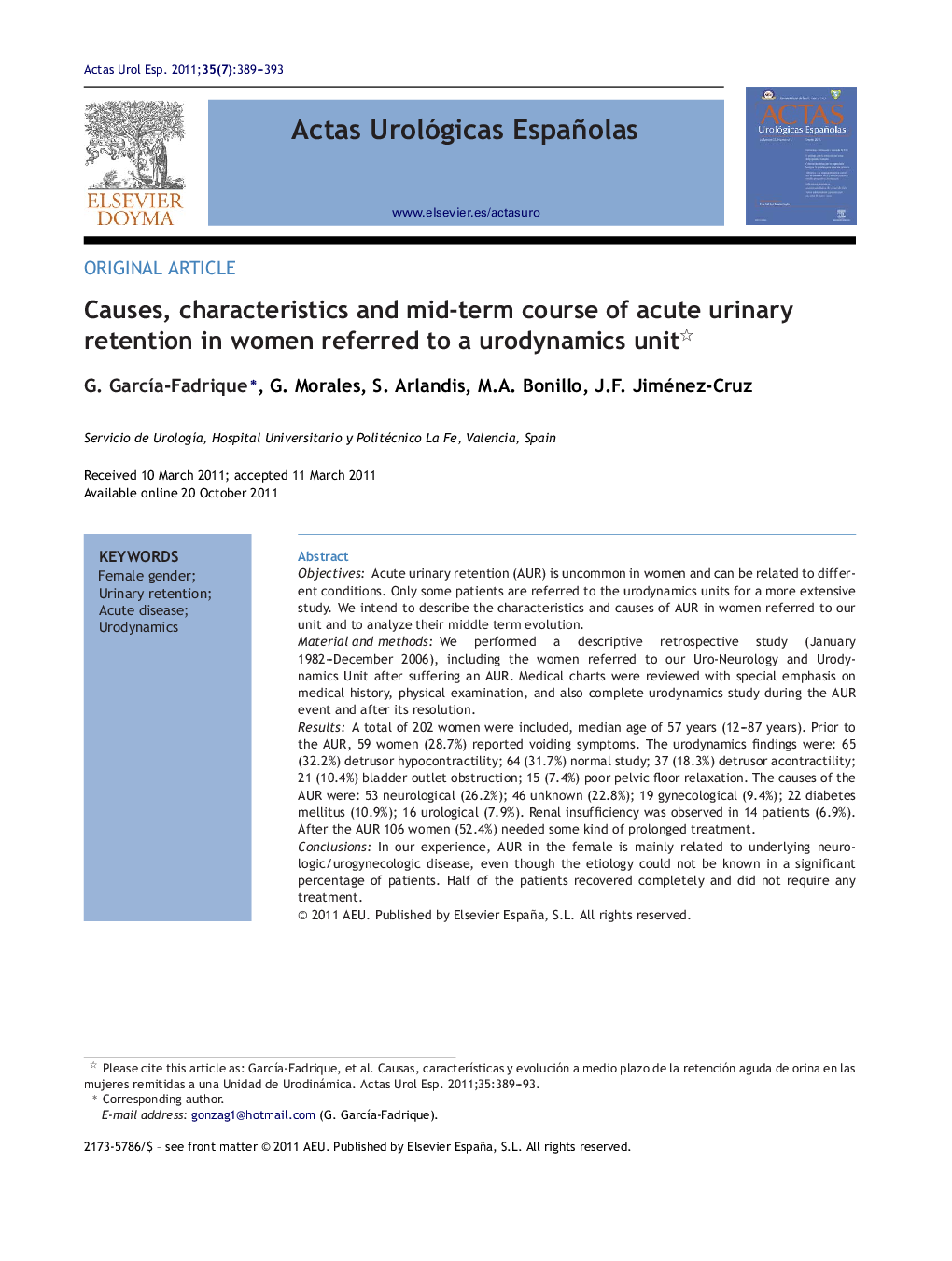| کد مقاله | کد نشریه | سال انتشار | مقاله انگلیسی | نسخه تمام متن |
|---|---|---|---|---|
| 3845744 | 1248289 | 2011 | 5 صفحه PDF | دانلود رایگان |

ObjectivesAcute urinary retention (AUR) is uncommon in women and can be related to different conditions. Only some patients are referred to the urodynamics units for a more extensive study. We intend to describe the characteristics and causes of AUR in women referred to our unit and to analyze their middle term evolution.Material and methodsWe performed a descriptive retrospective study (January 1982–December 2006), including the women referred to our Uro-Neurology and Urodynamics Unit after suffering an AUR. Medical charts were reviewed with special emphasis on medical history, physical examination, and also complete urodynamics study during the AUR event and after its resolution.ResultsA total of 202 women were included, median age of 57 years (12–87 years). Prior to the AUR, 59 women (28.7%) reported voiding symptoms. The urodynamics findings were: 65 (32.2%) detrusor hypocontractility; 64 (31.7%) normal study; 37 (18.3%) detrusor acontractility; 21 (10.4%) bladder outlet obstruction; 15 (7.4%) poor pelvic floor relaxation. The causes of the AUR were: 53 neurological (26.2%); 46 unknown (22.8%); 19 gynecological (9.4%); 22 diabetes mellitus (10.9%); 16 urological (7.9%). Renal insufficiency was observed in 14 patients (6.9%). After the AUR 106 women (52.4%) needed some kind of prolonged treatment.ConclusionsIn our experience, AUR in the female is mainly related to underlying neurologic/urogynecologic disease, even though the etiology could not be known in a significant percentage of patients. Half of the patients recovered completely and did not require any treatment.
ResumenObjetivosLa retención aguda de orina (RAO) es poco frecuente en mujeres y puede relacionarse con distintas patologías. Sólo algunas pacientes son remitidas a una Unidad de Urodinámica para un estudio más exhaustivo. Se pretende describir las características y causas de RAO en las mujeres derivadas a nuestra unidad y analizar su evolución a medio plazo.Material y métodosEstudio descriptivo retrospectivo (enero 1982- diciembre 2006) incluyendo las mujeres derivadas a la Unidad de Urodinámica tras sufrir una RAO. Se revisaron las historias clínicas con especial énfasis en antecedentes personales, exploración física, así como estudio urodinámico completo durante el episodio de RAO y una vez superado este.ResultadosSe incluyeron 202 mujeres, con una mediana de edad de 57 años (12- 87). Previamente 59 pacientes (28,7%) presentaban síntomas de vaciado. Los patrones urodinámicos que se encontraron fueron: 65 hipocontractilidad vesical (32,2%), 64 estudio normal (31,7%), 37 acontractilidad (18,3%), 21 obstrucción infravesical (10,4%) y 15 ausencia de relajación de suelo pélvico (7,4%). Las principales causas de RAO fueron: 53 neurológica (26,2%); 46 causa desconocida (22,8%); 19 ginecológica (9,4%); 22 diabetes mellitus (10,9%); y 16 urológica (7,9%). Deterioraron la función renal 14 mujeres (6,9%). Tras la RAO 106 mujeres (52,4%) necesitaron continuar con algún tipo de tratamiento.ConclusionesEn nuestra serie la RAO en mujeres suele ser consecuencia de una enfermedad neurológica o uroginecológica subyacente, aunque en un porcentaje importante de pacientes no se logra filiar la causa. La mitad de las pacientes se recuperaron totalmente y no precisaron ningún tipo de tratamiento.
Journal: Actas Urológicas Españolas (English Edition) - Volume 35, Issue 7, July–August 2011, Pages 389–393